
July 22
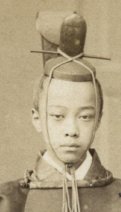
1831 Japan: The 121st Emperor is born: Emperor Kōmei (Kōmei-tennō). Kōmei will have six children: four daughters and two sons, but only one will survive past age two. (Craig)
[See: Countdown to Infamy: Timeline to Pearl Harbor.]
1892 Birth: Arthur Seyss-Inquart: Austrian Nazi leader. He served in the Austro-Hungarian army during World War I and was seriously wounded. Later a lawyer in Vienna, he became a leader of the moderate faction of the Austrian Nazis and served on the federal council of state (1937-38). In response to German pressure, he was named minister of interior and security and then replaced Kurt von Schuschnigg as chancellor (1938). He welcomed the Anschluss by Germany and became governor of the Austrian administration (1938-39). In World War II he was German high commissioner of The Netherlands (1940-45) and carried out the Nazi policy against Dutch Jews. He was tried at the Nuremberg trials and executed as a war criminal.
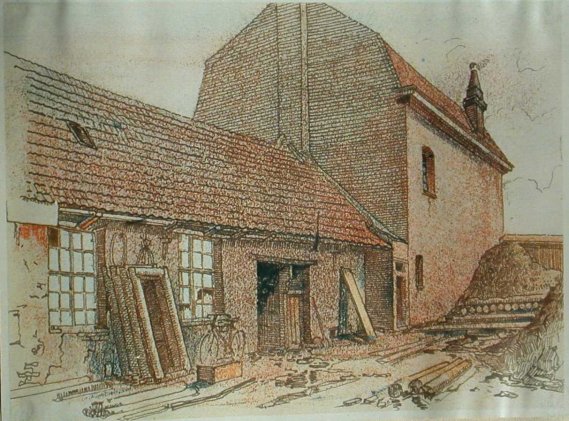
Fromelles Watercolor, 1915, by Hitler
1915 World War I: List Regiment: Gefreiter Adolf Hitler's 16 Reserve Infantry Regiment continues to occupy a position at Fromelles, on a level field with water channels, willow trees and willow stalks. In the distance towards the enemy lines lies an insignificant wood with barbed wire entanglements. Under the direction of their defense-minded commander, Lieutenant General Gustav Scanzoni von Lichtenfels, the regiment works ceaselessly day and night to further fortify their position at Fromelles while fighting off repeated assaults by the enemy. [For further details, Click here.]
1916 World War I: Various:
List Regiment: Gefreiter Adolf Hitler endures trench warfare in Flanders (Artois) with 3 Company, 16 Reserve Infantry Regiment. [For further details, Click here.]
USA: The Preparedness Day bombing:
In San Francisco, a bomb at a Preparedness Day parade on Market Street kills 10 people and wounds 40. The bomb was hidden in a suitcase. The parade was organized by the city's Chamber of Commerce in support of America's possible entrance into World War I. San Francisco was suffering through severe labor strife at the time, and many suspected that anti-war labor radicals were responsible for the terrorist attack. [For further details, Click here.]
1917 World War I: Various:
Russian Army Commander-in-Chief Alexei Brusilov's Official Announcement on the Kerenski Offensive:
Our troops, having manifested absolute disobedience to the commanders, continued to retreat to the River Sereth, part giving themselves up as prisoners. Only the 155th infantry division in the district of Dolzanka-Domamoricz, and the armoured cars which fired on the German cavalry on the Tarnopol road, put up any opposition to the enemy. With immense superiority in forces and technique on our side in the sections attacked, the retreat continued almost without a break. This was due to the absolute instability of our troops and discussions as to whether to obey or not to obey orders of commanders, and to the criminal propaganda of the Bolsheviks.
List Regiment: Gefreiter Adolf Hitler's 16th RIR remain deployed for Phase 1 operations in Flanders, Belgium. [For further details, Click here.]
1918 Various:
World War I: List Regiment (July 20-August 4): Gefreiter Adolf Hitler's 16th RIR is tasked with building a new line of defenses on the site of the failed Second Battle of the Marne. [For further details, Click here.]
Russian Revolution: Russian Constituent Assembly delegates begin fleeing to western Siberia and form their own "All-Russian" government, which is soon suppressed by a reactionary 'White' dictatorship under Admiral Aleksandr Kolchak. Army officers in southern Russia organize a 'Volunteer Army' under the leadership of Generals Lavr Kornilov and Anton Denikin and gain support from Britain and France. Both in the Volga region and the eastern Ukraine, peasants begin to organize against Bolshevik requisitioning and mobilization. Soon anarchist "Greens" are fighting the "Reds" (Bolsheviks) and Whites alike in guerrilla-type warfare. Even in Moscow and Petrograd, leftist Socialist Revolutionaries take up arms against the Bolsheviks, whom they accuse of betraying revolutionary ideals.
1919 July 22-25 Gefreiter Hitler attends political indoctrination classes at Lechfeld, aimed at training him as a Propagandaleute (propaganda agent) for the Reichswehr. The Aufklarungskommando, or clarification detachment, is commanded by Rudolf Beyschlag, and his first report to Captain Mayr will mention Hitler assisting in guiding the discussion sessions after Beyschlag's lectures. Subsequent reports to Mayr make it clear that Hitler is the standout among the first group.
Professor Karl Alexander von Mueller:[After one of my lectures, I encountered a group of students that] stood fascinated around a man in their midst [Hitler] who was addressing them without pause and with growing passion in a strangely guttural voice. I had the strange feeling that the man was feeding on the excitement which he himself had whipped up. I saw a pale, thin face beneath a drooping, unsoldierly strand of hair, with close-cropped mustache, and strikingly large, light blue eyes coldly glistening with fanaticism. [For further details, Click here.]

1928 Hitler writes to Artur Dinter, publisher of a new Weimar newspaper, Der Nationalsozialist, and NSDAP State Leader of Thuringia: "As leader of the National Socialist Movement and as a person who possesses the blind faith of someday belonging to those who make history, I have [as a politician] the boldness to claim for myself in this sphere the same infallibility that you reserve for yourself in your [religious] reformationist area." [For further details, Click here.]
1933 Church and Reich: The text of the Concordat is released to the press. A secret annex is never announced to the public, or even to party members (see August 29, 1939).
1938 Holocaust: The Third Reich issues special identity cards for Jewish Germans. (THP)
1940 World War II: Lord Halifax, British Foreign Secretary, replies to Hitler's call for peace, saying, 'We shall not stop fighting till freedom for ourselves and others is secure.'
1941 World War II: Various:
US troops occupy Iceland: to provide protection for American ships sailing to England. President Franklin Roosevelt says it is to prevent the island's occupation by Germany.
[See: War Below Zero.]Barbarossa: The German advance is temporarily halted to allow infantry and supplies to catch up to the Panzer armies. The Germans are experiencing a new kind of warfare. The Russians seem content to trade 10 Russian lives for 1 German. They continually mount reckless counter-attacks. These wasteful attacks have an unnerving effect on the Wehrmacht. (Clark II)
Besides blunders in strategic planning, the Nazi leadership also hurt the German cause in the East by promoting its racist ideology. Nazi propaganda "prepared the soil for the concept of "Untermensch" (human beings of lesser value)." The Nazis and the Wehrmacht rationalized that the Russians and the Jews merited harsh treatment, because of their racial inferiority. Also, as has already been stated, the Germans planned on using much of this land for their Lebensraum. Hitler basically wanted the European portion of the Soviet Union, from Archangel on the White Sea to Astrakhan on the Caspian Sea (the "AA Line"). Therefore, the majority of the people living there would have to be moved, and this was to be accomplished by "harsh" (barbaric) measures. Prior to the invasion, in June 1941, the OKW and OKH issued the so-called "criminal orders" which, among other things, provided for the execution of civilians!
These policies along with those dealing with prisoners of war and indigenous personnel willing to help Germany contributed to the German defeat. As author Frederick Schuman sums it up, "The Nazi cult of violence doomed the Nazi leaders, in the end to death." Thus, the racist ideology promoted by Hitler and the Nazis led to the justification of extreme violence, even in the context of warfare, against the indigenous population of the Soviet Union, which was counter-productive. The masses of the Soviet Union were discontent with Stalin, and had Hitler been a little more flexible—even temporarily—the results might have been different for Germany.
[See: What Were Adolf Hitler's Major Blunders?]
Holocaust:
Nazi killing squads arrive in Bessarabia: Romanian troops and militias murder thousands of Jews in the area of their advance. Following the initial killings, internment camps are set up throughout the province. At the camp in Edineti, 70 to 100 people die every day in July and August, mostly of starvation. In all, more than 148,000 Bessarabian Jews perish in the ghettos and camps of Transnistria. (THP)
The German advance in Russia has been so rapid that less than 300,000 of Russia's 2.7 million Jews are able to escape to safety beyond the Volga River. (THP)
Himmler orders the enlargement of Auschwitz and the addition of a killing center.
1942 World War II: Various:
Gasoline rationing (petrol) begins in the US. To get the gasoline ration classification and ration stamps, you had to certify to a local board that you needed gas and owned no more than five tires. Ration stamps were issued and pasted to an automobile windshield. A family's gasoline allotment was determined by the class of stamp displayed. The class of stamp was determined by the primary use of the car.
Poland: The desperate Polish underground recommends that the Allies turn over Germans in their countries to the Polish Government-in-Exile; for every Pole killed, 100 of the Germans would be eliminated. The Allies decline.
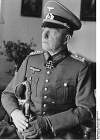
Barbarossa: Units of 1st Panzerarmee (von Kleist) are fighting their way into the northern outskirts of Rostov-on-Don which is fiercely defended by the Red Army.
Holocaust: Deportations from Warsaw ghetto to Treblinka begin:

On this day in 1942, the systematic deportation of Jews from the Warsaw ghetto begins, as thousands are rounded up daily and transported to a newly constructed concentration/extermination camp at Treblinka, in Poland.
On July 17, Heinrich Himmler, head of the Nazi SS, arrived at Auschwitz, the concentration camp in eastern Poland, in time to watch the arrival of more than 2,000 Dutch Jews and the gassing of almost 500 of them, mostly the elderly, sick, and very young. The next day, Himmler promoted the camp commandant, Rudolph Hoess, to SS major and ordered that the Warsaw ghetto, (the Jewish quarter constructed by the Nazis upon the occupation of Poland, enclosed first by barbed wire and then by brick walls), be depopulated-a "total cleansing," as he described it and the inhabitants transported to what was to become a second extermination camp constructed at the railway village of Treblinka, 62 miles northeast of Warsaw.
Within the first seven weeks of Himmler's order, more than 250,000 Jews were taken to Treblinka by rail and gassed to death, marking the largest single act of destruction of any population group, Jewish or non-Jewish, civilian or military, in the war. Upon arrival at "T. II," as this second camp at Treblinka was called, prisoners were separated by sex, stripped, and marched into what were described as "bathhouses," but were in fact gas chambers. T.II's first commandant was Dr. Irmfried Eberl, age 32, the man who had headed up the euthanasia program of 1940 and had much experience with the gassing of victims, especially children. He compelled several hundred Ukrainian and about 1,500 Jewish prisoners to assist him. They removed gold teeth from victims before hauling the bodies to mass graves. Eberl was relieved of his duties for "inefficiency." It seems that he and his workers could not remove the corpses quickly enough, and panic was occurring within the railway cars of newly arrived prisoners.
By the end of the war, between 700,000 and 900,000 would die at either Treblinka I or II. Hoess was tried and sentenced to death by the Nuremberg Tribunal. He was hanged in 1947.
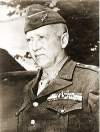
1943 World War II: Sicily: The US Seventh Army led by Gen. George S. Patton prepares to take Palermo. (See July 23)
[See: How Did the Pact of Steel Effect Germany and Italy?]1944 World War II: Various:
The Soviets set up a Polish Committee of National Liberation:
During 1943 and 1944 the Allied leaders, particularly Winston Churchill, tried to bring about a resumption of talks between Stalin and the Polish Government in Exile. But these efforts broke down over several matters. One was the Katyn massacre (and others at Kalinin and Kharkiv). Another was Poland's postwar borders. Stalin insisted that the territories annexed by the Soviets in 1939, which had millions of Poles in addition to Ukrainian and Belarusian populations, should remain in Soviet hands, and that Poland should be compensated with lands to be annexed from Germany. Mikolajczyk, however, refused to compromise on the question of Poland's sovereignty over her prewar eastern territories. A third matter was Mikolajczyk's insistence that Stalin not set up a Communist government in postwar Poland.
Eastern front: Soviet 1st Belorussian Front recaptures Chelm.
Holocaust: As Russian troops approach Lublin and the nearby death camp at Majdanek, the Germans march 1,200 Jews westward toward Kielce, where 180 are murdered. The survivors are sent by train to Auschwitz, where 200 more are gassed on arrival.
In late July 1944, the Germans hastily evacuated the camp. But the staff had only succeeded in partially destroying the crematoria before Soviet Red Army troops arrived on July 22, 1944, making Majdanek the best-preserved camp of the Holocaust. It was the first major concentration camp liberated by Allied forces, and the horrors found there were widely publicized.
Although 1,000 inmates had previously been forcibly marched to Auschwitz (of whom only half arrived alive), the Red Army still found thousands of inmates, mainly POWs, still in the camp and ample evidence of the mass murder that had occurred there.
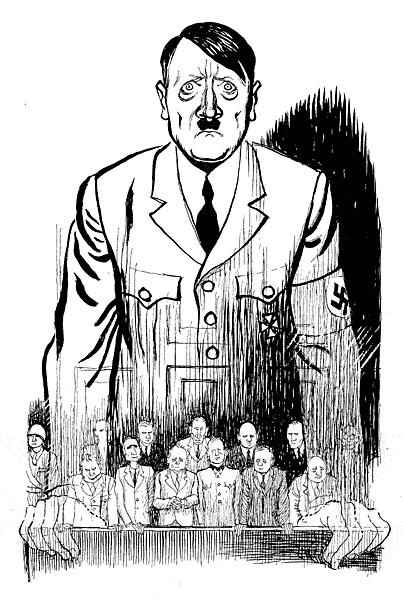
1946 Nuremberg Tribunal: Defense summations continue in the Major War Criminals Trial. One point in common with nearly all of the arguments of the various Defense Counsel is that there is a major absence among the Defendants; Adolf Hitler himself.
Dr. Friedrich Bergold (Counsel for Defendant Martin Bormann):The case of the Defendant Martin Bormann, whose defense the Tribunal has commissioned me to undertake, is an unusual one. When the sun of the National Socialist Reich was still at its zenith, the defendant lived in the shade. Also during this Trial he has been a shadowy figure, and in all probability, he has gone down to the shades-that abode of departed spirits, according to the belief of the ancients. He alone of the defendants is not present, and Article 12 of the Charter applies only to him. It seems as though history wanted to preserve the continuity of the genius loci and to have chosen the town of Nuremberg to be the scene of a discussion as to whether the fact that a defendant is allegedly no longer alive, can obstruct his being tried in contumaciam, in absentia. In Nuremberg we have an adage which has come down to us from the Middle Ages, and which says: "The Nurembergers would never hang a man they did not hold." Thus, even in former times they had an excellent way in Nuremberg of dealing with the question as to how proceedings can be taken against a person in his absence.
Dr. Egon Kubuschok (Counsel for Defendant Franz von Papen):In his Marburg speech of 17 June 1934 Papen distinctly branded all abuses which had become apparent until then. Such extensive public criticism remained unique in the history of the Third Reich.
He realized that the danger of Nazism lay in the fact that its different doctrines were so interlocked that they formed an iron ring of oppression on all of public life. Had only one link of that ring been smashed, the dangerous character of the entire system would have been averted. If only one of the points discussed had met with practical success in a favorable sense, it would have meant a total change of conditions. The system objected to could not have existed another day if the freedom of speech demanded by Papen had been granted. It could not have been upheld if the conception of justice and of equality before the law were recognized. It could not have existed if freedom of religion were guaranteed. A Marxist mass theory cannot be upheld if the maxim of the individual's equality, common to all confessions, is advocated.
Each of Papen's attacks in his Marburg speech-he had dealt with the racial issue already in his Gleiwitz speech-was in itself an attack upon the development of the entire Nazi doctrine. Here a leading member of the opposition in the Government clearly indicated the source of the abuses.
The consequences of such an action were foreseen by Papen from the very beginning. Either Hitler would take into consideration the new state of affairs after it had become a matter of public discussion, or Papen was going to offer his resignation, since he could no longer reconcile further co-operation with the path chosen by Hitler.
Evidently Hitler at that time did not consider it necessary to make a concession to public opinion by deviating from his line of action. He tried to kill the opposition by forbidding the publication of the speech and by penalizing its distributors. Papen resigned. Hitler did not accept this resignation immediately, since he obviously had to take Hindenburg into consideration, wishing to clear up the situation first of all with him.
1950 Belgium: Following an indecisive referendum, King Leopold III, accused of collaboration with Nazi Germany, returns to Belgium, beginning an escalation of the political crisis known as the Royal Question. [For further information, click here.]
Edited by Levi Bookin (Copy editor)
levi.bookin@gmail.com



Click to join 3rdReichStudies

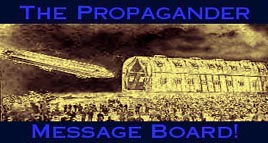

Disclaimer: This site includes diverse and controversial materials—such as excerpts from the writings of racists and anti-Semites—so that its readers can learn the nature and extent of hate and anti-Semitic discourse. It is our sincere belief that only the informed citizen can prevail over the ignorance of Racialist "thought." Far from approving these writings, this site condemns racism in all of its forms and manifestations.
Fair Use Notice: This site may contain copyrighted material the use of which has not always been specifically authorized by the copyright owner. We are making such material available in our efforts to advance understanding of historical, political, human rights, economic, democracy, scientific, environmental, and social justice issues, etc. We believe this constitutes a "fair use" of any such copyrighted material as provided for in section 107 of the US Copyright Law. In accordance with Title 17 U.S.C. Section 107, the material on this site is distributed without profit to those who have expressed a prior interest in receiving the included information for research and educational purposes. If you wish to use copyrighted material from this site for purposes of your own that go beyond 'fair use', you must obtain permission from the copyright owner.
Please Note: The list-owner and moderators of 3rdReichStudies are not responsible for, and do not necessarily approve of, the random ads placed on our pages by our web server. They are, unfortunately, the price one pays for a 'free' website.